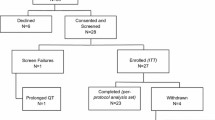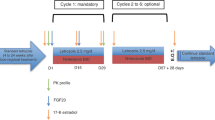Abstract
Three phase II studies were conducted to determine the efficacy and tolerability of liarozole fumarate (R85246; liarozole), a retinoic acid metabolism blocking agent (RAMBA) and aromatase inhibitor. Additionally, animal experiments in the MNU-induced rat mammary tumor model and in immature ovariectomized rats were conducted to further elucidate liarozole's mechanisms of action. Patients were postmenopausal with either: ER negative disease in first relapse (Group 1; n = 16); ER positive or unknown disease refractory to tamoxifen (Group 2; n = 16); ER positive, negative or unknown disease resistant or refractory to chemotherapy (Group 3; n = 27). Treatment was liarozole (150–300 mg) twice daily orally until disease progression. Response rates were: 25% in group 1 (95% CI 11.0–52.3%; median duration (MD) 20 months; range 2–36.5); 25% in group 2 (95% CI 11.0–52.3%; MD 6.5 months; range 3.5–38); 11% in group 3 (95% CI 4.2–29.2%; MD 7 months; range 3–8.5). No significant improvement in quality of life scores (FLI-C) was noted. Toxicities observed were predominantly dermatological (skin disorders: 88%; dry mouth/eyes/lips: 69%). Plasma estradiol decreased from mean pre-treatment levels of 72.7 pM (9.1–1839 pM) to below detection (9.2 pM) after 1 month. Liarozole, but not vorozole, partially inhibited estradiol induced uterine hypertrophy and demonstrated dose-dependent anti-tumor effects in the rats, only partially overcome by coadministration of estradiol. The clinical responses observed, together with our preclinical results, confirm liarozole's dual mechanism of action and provide a rationale for further evaluation of RAMBAs in the treatment of breast cancer.
Similar content being viewed by others
References
Henderson IC: Endocrine therapy in metastatic breast cancer. In: Harris JR, Hellman S, Henderson IC, Kinne DW (eds) Breast Diseases, JB Lippincott, Philadelphia, 1987, p 421
Kostraba N, Kiang D, Fremming D, et al.: Multiple endocrine therapy in the management of advanced breast cancer. Proc AACR 21: 147, 1980
Buzdar A, Jonat W, Howell A, Jones SE, Blomqvist C, Vogel CL, Eiermann W, Wolter JM, Azab M, Webster A, Plourde PV: Anastrozole (Arimidex), a potent and selective aromatase inhibitor, vs megestrol acetate (Megace) in postmenopausal women with advanced breast cancer: Results of overview analysis of two phase III trials. J Clin Oncol 14: 2000–2011, 1996
Gershanovich M, Chaudri HA, Campos D, Lurie H, Bonaventura A, Jeffrey M, Buzzi F, Bodrogi I, Ludwig H, Reichardt P, O'Higgins N, Romieu G, Friederich P, Lassus M: Letrozole, a new oral aromatase inhibitor: Randomised trial comparing 2.5mg daily, 0.5mg daily and aminoglutethimide in postmenopausal women with advanced breast cancer. Ann Oncol 9: 639–645, 1998
Dombernowsky P, Smith I, Falkson G, Leonard R, Panasci L, Bellmunt J, Bezwoda W, Gardin G, Gudgeon A, Morgan M, Fornasiero A, Hoffmann W, Michel J, Hatschek T, Tjabbes T, Chaudri HA, Hornberger U, Trunet PF: Letrozole, a new oral aromatase inhibitor for advanced breast cancer: Double-blind randomized trial showing a dose effect and improved efficacy and tolerability compared with megestrol acetate. J Clin Oncol 16: 453–461, 1998
Taylor SG, Gelman RS, Falkson G, Cummings FJ: Combination chemotherapy compared to tamoxifen as initial therapy for Stage IV breast cancer in elderly women. Ann Int Med 104: 455–461, 1986
Denis L, Debruyne F, De Porre P, Bruynseels J: Early clinical experience with liarozole (LiazalTM) in patients with progressive prostate cancer. Eur J Cancer 34: 469–475, 1998
Debruyne FJ, Murray R, Fradet Y, Johansson JE, Tyrrell C, Boccardo F, Denis L, Marberger JM, Brune D, Rassweiler J, Vangeneugden T, Bruynseels J, Janssens M, De Porre P: Liarozole - a novel treatment approach for advanced prostate cancer: Results of a large randomized trial versus cyperoterone acetate. Urology 52: 72–81, 1998
Goss PE, Oza A, Rakesh G, Nabholtz J, De Coster R, Bruynseels J, Reid C, Wadden N, Crump M, Tye LM: Liarozole fumarate (R85246): A novel imidazole in the treatment of receptor positive postmenopausal metastatic breast cancer. Breast Cancer Res Treat 1545: 1–14, 2000
O'Byrne KJ, Han C, Mitchell K, Lane D, Carmichael J, Harris AL, Talbot DC: Phase II study of liarozole in advanced nonsmall cell lung cancer. Eur J Cancer 34: 1463–1466, 1998
Donkx P, Decree J, Degreef H: Inhibition of the metabolism of endogenous retinoic acid as treatment for severe psoriasis: an open study with oral liarozole. Br J Dermatol 133: 426–432, 1995
Lucker GP, Heremans AM, Boegheim PJ, van de Kerkhof PC, Steijlen PM: Oral treatment of ichthyosis by the cytochrome P-450 inhibitor liarozole. Br J Dermatol 136: 71–75, 1997
Bruynseels J, De Coster R, Van Rooy P, Wouters W, Coene MC, Snoeck E, Raeymaekers A, Freyne E, Sanz G, Vanden Bussche G: R75251, a new inhibitor of steroid biosynthesis. Prostate 16: 345–357, 1990
Van Wauwe JP, Coene MC, Goossens J, Cools W, Monbaliu J: Effects of cytochrome P-450 inhibitors on the in vivo metabolism of all-trans-retinoic acid in rats. J Pharmacol Exp Ther 252: 365–369, 1990
Van Wauwe J, Van Nyen G, Coene MC, Stoppie P, Cools W, Goossens J, Borghgraef P, Janssen PA: Liarozole, an inhibitor of retinoic acid metabolism, exerts retinoid-mimetic effects in vivo. J Pharmacol Exp Ther 261: 773–779, 1992
Van Wauwe J, Coene MC, Cools W, Goossens J, Lauwers W, Le Jeune L, Van Hove C, Van Nyen G: Liarozole fumarate inhibits the metabolism of 4-keto-all-trans-retinoic acid. Biochem Pharmacol 47: 737–741, 1994
Fishman B, Pasternak S, Wallenstein SL, Houde RW, Holland JC, Foley KM: The Memorial Pain Assessment Card: a valid instrument for the measurement of cancer pain. Cancer 60: 1151–1157, 1987
World Health Organization. Cancer Pain Relief, Geneva, 1986
Schipper H, Clinch J, McMurray A, Levitt M: Measuring the quality of life of cancer patients: The Functional Living Index-Cancer: development and validation. J Clin Oncol 2: 472–483, 1984
World Health Organization: Handbook for reporting results of cancer treatment. Offset Publication No. 48 WHO, Geneva 1979
De Coster R, Beerens D, Dom J, Willemsens G: Endocrinological effects of single daily ketoconazole therapy in male beagle dogs. Acta Endocrinol. 107: 275–281, 1984
De Coster R, Caers I, Coene MC, Amery W, Beerens D, Haelterman C: Effects of high dose ketoconazole therapy on the main plasma testicular and adrenal steroids in previously untreated prostatic cancer patients. Clin Endocrinol 24: 657–664, 1986
Woestenborghs R, et al.: HPLC-fluorescence method for the determination of R075251 in plasma and animal tissues. Janssen Research Foundation, September 1989; Preclinical Research Report R061405/3
Thompson HJ, Adlakha H: Dose-responsive induction of mammary gland carcinoma by the intraperitoneal injection of 1-Methyl-1-nitrosourea. Cancer Res 51: 3411–3415, 1991
Odum J, Lefevre PA, Tittensor S, Paton D, Routledge EJ, Beresford NA, Sumpter JP, Ashby J: The rodent uterotrophic assay: Critical protocol features, studies with nonyl phenols, and comparison with a yeast estrogenicity assay. Regul Toxicol Pharmacol 25: 176–188, 1997
Crowder MJ, Hand DJ: Analysis of Repeated Measures. Chapman & Hall, London, England, 1990
Littell RC, Milliken GA, Stroup WW, Wolfinger RD: SAS System for Mixed Models, Cary, NC: SAS Institute Inc., 1996
SAS Institute Inc.: SAS/STAT User's Guide, Release 6.03 Edition. Cary, NC: SAS Institute Inc., 1988
Becker RA, Chambers JM, Wilks AR: The New S Language. Wadsworth, Pacific Grove, California, 1988
Smith GA: Current status of vinorelbine for breast cancer. Oncology (Huntingt) (United States), Aug 1995, 9(8) 767–773; discussion 774, 776, 779
Blum JL: Xeloda in the treatment of metastatic breast cancer. Oncology (Switzerland), 57 (Suppl 1) 16–20, 1999
Schule R, Rangarajan P, Yang N, Kliewer S, Ransone LJ, Bolado J, Verma IM, Evans RM: Retinoic acid is a negative regulator of AP-1 responsive genes. Proc Natl Acad Sci USA 88: 6092–6096, 1991
Nicholson RC, Mader S, Nagpal S, Leid M, Rochette-Egly C, Chambon P: Negative regulation of the rat stromelysin gene promoter by retinoic acid is mediated by an AP-1 binding site. EMBO J 9: 4443–4454, 1990
Lacroix A, Lippman ME: Binding of retinoids to human breast cancer cell lines and their effects on growth. J Clin Invest 65: 586–591, 1980
Fontana JA, Hobbs PD, Dawson MI: Inhibition of mammary carcinoma growth by retinoidal benzoic acid derivatives. Exp Cell Biol 56: 254–263, 1988
Fontana JA, Miksis G, Miranda DM, Durham JP: Inhibition of human mammary carcinoma cell proliferation by retinoids and intracellular cAMP-elevating compounds. J Natl Cancer Res 78: 1107–1112, 1987
Fontana JA, Mezu AB, Cooper BN, Miranda D: Retinoid modulation of estradiol-stimulated growth and of protein synthesis and section in human breast carcinoma cells. Cancer Res 50: 1997–2002, 1990
Hamilton A, Piccart M: The third-generation non-steroidal aromatase inhibitors: A review of their clinical benefits in the second-line homonal treatment of advanced breast cancer. Annals of Oncology 10: 377–384, 1999
Blum JL: Xeloda in the Treatment of Metastatic Breast Cancer. Oncology 57 (suppl 1): 16–20, 1999
Bunnell CA, Winer EP: Oral 5-FU analogues in the treatment of breast cancer. Oncology (Huntingt), 12(10 Suppl 7): 39–43, 1998
Blum JL, Jones SE, Buzdar AU, Lo Russo PM, Kuter I, Vogel C, Osterwalder B, Burger HU, Brown CS, Griffin T: Multicenter phase II study of capecitabine in paclitaxel-refractory metastatic breast cancer. J Clin Oncol (United States) 17(2): 485–493, 1999
Demers LM, Lipton A, Harvey HA, Kambic KB, Grossberg H, Brady C, Santen RJ: The efficacy of CGS 20267 in suppressing estrogen biosynthesis in patients with advanced stage breast cancer. J Steroid Biochem Mol Bio 44: 687–691, 1993
Geisler J, King N, Dowsett M, Ottestad L, Lundgren S, Walten P, Kormeset PO, Lonning PE: Influence of anastrozole (Arimidex), a selective, non-steroidal aromatase inhibitor, on in vivo aromatisation and plasma oestrogen levels in postmenopausal women with breast cancer. Br J Cancer 74(8): 1286–1291, 1996
Warrell, RP: Retinoid resistance in acute promyelocytic leukemia: new mechanisms, strategies and implications. Blood, 82(7): 1949–1953, 1993
Torrisi R, Parodi S, Fontana V: Factors affecting plasma retinol decline during long-term administration of the synthetic retinoid fenretinide in breast cancer patients. Cancer Epidemiol Biom Prev 3: 507–510, 1994
Author information
Authors and Affiliations
Rights and permissions
About this article
Cite this article
Goss, P.E., Strasser, K., Marques, R. et al. Liarozole Fumarate (R85246): In the Treatment of ER Negative, Tamoxifen Refractory or Chemotherapy Resistant Postmenopausal Metastatic Breast Cancer. Breast Cancer Res Treat 64, 177–188 (2000). https://doi.org/10.1023/A:1006480504790
Issue Date:
DOI: https://doi.org/10.1023/A:1006480504790




